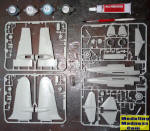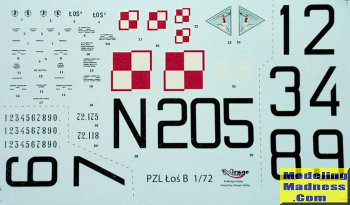
Mirage 1/72 PZL.37B 'Los'
| KIT #: | 872092 |
| PRICE: | Around €20 |
| DECALS: | One option |
| REVIEWER: | Spiros Pendedekas |
| NOTES: | Model set, containing paints, brushes and glue |

| HISTORY |
The PZL-37 Łoś (moose) was a Polish twin-engined medium bomber designed and manufactured by national aircraft company PZL. Upon its introduction to service, it was popularly considered not only the most modern and effective weapon possessed by Poland, but also one of the most advanced bombers then operational in the world.
From mid-1938 onwards, interest was expressed by various nations in potential export sales. In response to this highly favorable reception, PZL developed additional variants that were intended for the export market. Additionally, an improved enlarged derivative, known as the PZL-49 Miś, was developed for the Polish Air Force.
The Łoś was extensively used in the defense of Poland during the rapid invasion by Germany in September 1939, where it suffered from a high attrition rate due to lack of fighter protection. During October 1940, 26 or 27 machines that had been evacuated from Poland were seized by the Romanian government and 23 of them were subsequently used by the Royal Romanian Air Force, including offensive missions against the Soviet Union.
Over 120 Łoś were built with the first 10 production units featuring single large fins, the rest fitted with double tail fins.
| THE KIT |
 The
Mirage kit is a 2016 rebox of the venerable ZTS Plastyk that was introduced in
1983 and is regularly reboxed ever since (also by Mastercraft / Mistercraft, 21
times so far) with the molds totally unchanged. The specific boxing is a “model
set”, containing, apart from the kit itself, four acrylic paints (Polish khaki,
light blue, silver and black), a two sided (broad/fine) paint brush and a tube
of glue. It comes in a quality top opening box, with a very attractive box art
of a PZL-37 seen from below.
The
Mirage kit is a 2016 rebox of the venerable ZTS Plastyk that was introduced in
1983 and is regularly reboxed ever since (also by Mastercraft / Mistercraft, 21
times so far) with the molds totally unchanged. The specific boxing is a “model
set”, containing, apart from the kit itself, four acrylic paints (Polish khaki,
light blue, silver and black), a two sided (broad/fine) paint brush and a tube
of glue. It comes in a quality top opening box, with a very attractive box art
of a PZL-37 seen from below.
Upon opening the relatively large box, I was greeted with 72 light gray styrene
parts arranged in four equally sized sprues, all sealed together in a bag.
Molding is definitely old school, with raised details all over (and tad
overdone). The sprue gates are thick and a good amount of flash is evident,
together with mold shifting, meaning that some serious parts cleanup will be
ahead of you.
Although the kit is labeled as “B” double finned version, the single big fin is
also included. Though not mentioned in the instructions, you can construct the
single fin version should you wish: all you have to do is cut off the top spine
portion at the tail and attach the single fin.
Pilot and bombardier “offices”, which are quite visible through the extensive
glazing, are reasonably appointed for the scale (but with the parts detailing
not that refined), containing instrument panel, control column, seats and a good
number of details molded onto the sidewalls (levers, consoles and various
boxes). The rest of the interior, including the rear gunner’s area is also
reasonably appointed.
Landing gear is acceptable, with the wheels, gear legs and doors looking
passable. Simplified bays are also provided. Engines are averagely represented,
with the cylinders and crankcase molded together with the cowling lip. The props
have correct shape, but only one type of spinner hub is provided (the short,
bulbous one, when most P-37s seem to carry the longer, pointy spinners). The
distinctive heat exchangers are separately provided and will look passable with
some cleaning and proper painting.
Clear parts are thick and not that clear, deeming the interior not too visible.
At least, their sprue gates seem to not penetrate into the parts themselves.
Instructions are provided as a folded A3 sized leaflet in both Polish and
English, containing a thorough history at the front, followed by the
construction sequence spread in 12 clear steps at the next two pages.
Color callouts are given
throughout construction in both generic and Vallejo codes. One exception is the
cabin, where, though the interior color is referred as code “F”, no such code
could be found throughout the instructions, no matter how hard I searched. This
omission is easily solvable, though, you just have to download the Mastercraft
reboxing superb instructions (praise the Net days!).
 Only one
scheme is provided, for machine #72.118, as it stood in Małaszewicze during
August 1939, wearing the typical Polish Khaki over Light Blue camo. Decals look
thin and are superbly printed. Many different serial numbers and underwing codes
are provided as extras (except for the white big numbers found near the serial
numbers), meaning that, with some research and sourcing of the white digits, the
modeler can easily render other Polish machines, since all seemed to wear the
exact same camo.
Only one
scheme is provided, for machine #72.118, as it stood in Małaszewicze during
August 1939, wearing the typical Polish Khaki over Light Blue camo. Decals look
thin and are superbly printed. Many different serial numbers and underwing codes
are provided as extras (except for the white big numbers found near the serial
numbers), meaning that, with some research and sourcing of the white digits, the
modeler can easily render other Polish machines, since all seemed to wear the
exact same camo.
Instructions want you to first assemble the interior and trap it between the
fuselage halves, then assemble and attach the tail, followed by the canopy and
glazed nose. The wings are then to be assembled and attached, followed by the
landing gear and the engines with their props, of what seems to be an uncomplex
(but not necessarily uncomplicated) construction.
| CONCLUSIONS |
This is definitely an old
school kit, with its general shape looking correct and detailing varying from
average to sufficient. Molding is also average and not that refined, meaning the
potential builder will definitely have to perform a significant amount of
cleanup. Clear parts are not among the best I have ever seen, but should do the
job. Instructions are good with only an easily solvable interior color
definition issue.
Construction does not seem too difficult, deeming this kit suitable to anyone
(but the absolute rookie) willing to perform some serious parts cleanup. Decals
are great and will enhance the looks of the completed model. Provided that parts
will be well cleaned and the modeler will be willing to perform some respectable
amount of filing and sanding, my feeling is that a good looking model can emerge
even out of the box.
IBG came with a new tool PZL-37 in 2018: though “high end limited run” in
nature, it looks superb allover and should result in a most accurate rendition
of the important bomber. Regularly reissued, very sensibly priced and
practically covering every scheme and version, it is by all means the way to go
if you want the best 1/72 PZL-37!
The Mirage "model set" costs just a bit less than the superb IBG, but one has to
take into account the extra cost of the “model set” goodies (paints, double
brush and glue). The basic kit (under MisterCraft or ZTS labeling) costs roughly
four times less than the IBG. Is it four times worse? Probably not. So the
modeler has a choice here.
Happy modeling!
February 2022
Copyright ModelingMadness.com. All rights reserved. No reproduction in part or in whole without express permission.
If you would like your product reviewed fairly and fairly quickly, please contact the editor or see other details in the Note to Contributors.